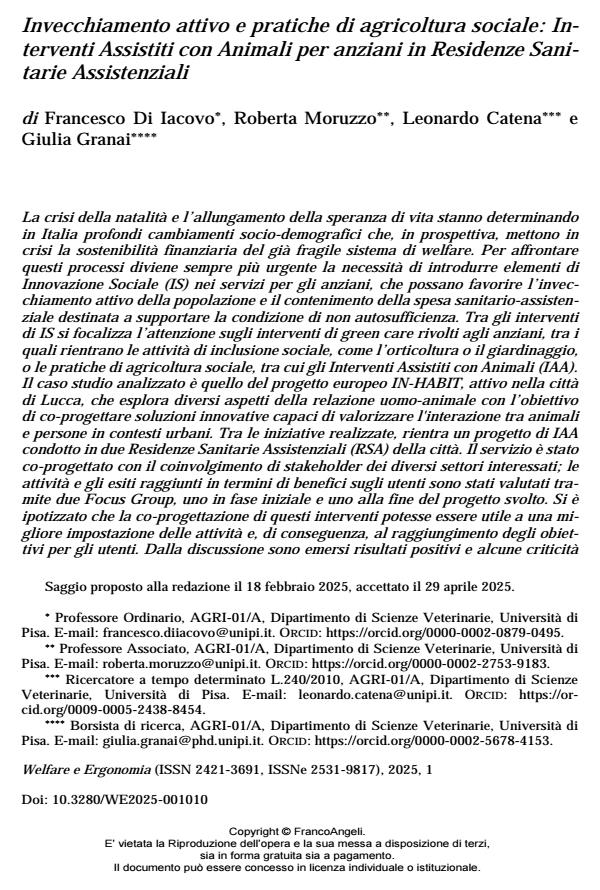Invecchiamento attivo e pratiche di agricoltura sociale: Interventi Assistiti con Animali per anziani in Residenze Sanitarie Assistenziali
Journal title WELFARE E ERGONOMIA
Author/s Francesco Di Iacovo, Roberta Moruzzo, Leonardo Catena, Giulia Granai
Publishing Year 2025 Issue 2025/1
Language Italian Pages 16 P. 151-166 File size 117 KB
DOI 10.3280/WE2025-001011
DOI is like a bar code for intellectual property: to have more infomation
click here
Below, you can see the article first page
If you want to buy this article in PDF format, you can do it, following the instructions to buy download credits

FrancoAngeli is member of Publishers International Linking Association, Inc (PILA), a not-for-profit association which run the CrossRef service enabling links to and from online scholarly content.
Italy is facing significant socio-demographic shifts due to a declining birthrate and increased life expectancy. These changes are jeopardizing the financial stability of its already fragile welfare system. To address this, there’s a pressing need to introduce Social Innovation (SI) into services for the elderly. The goal is to promote active aging while containing healthcare and social care costs, particularly those associated with supporting non-self-sufficient individuals. Among various SI initiatives, green care interventions for the elderly are gaining traction. These include social inclusion activities like horticulture and gardening, as well as social farming practices, such as Animal Assisted Interventions (AAI). This context leads us to examine the European project IN-HABIT, active in Lucca. This project explores the human-animal bond, striving to co-design innovative solutions that enhance interactions between people and animals in urban settings. A key part of IN-HABIT is an AAI project implemented in two Residential Healthcare Facilities (RSA) in Lucca. The AAI service was developed through a co-design process, involving stakeholders from various relevant sectors. Its activities and the benefits for users were assessed using two Focus Groups ‒ one at the project’s early stage and another at its conclusion. The underlying hypothesis was that co-designing these interventions would lead to better structured activities and, consequently, more effective outcomes for elderly residents. The discussions revealed both positive results and some critical issues, particularly concerning the project’s organization and the perceived impact of the interventions on the elderly.
Keywords: green care; active aging; older adults; Animal Assisted Interventions.
Francesco Di Iacovo, Roberta Moruzzo, Leonardo Catena, Giulia Granai, Invecchiamento attivo e pratiche di agricoltura sociale: Interventi Assistiti con Animali per anziani in Residenze Sanitarie Assistenziali in "WELFARE E ERGONOMIA" 1/2025, pp 151-166, DOI: 10.3280/WE2025-001011